Free Swinging Tube Fly Hook
How to make a simple heat-shrink Knot
Guard
allowing the tube fly hook to swing freely
First described
by John Gray in Trout and Salmon Magazine, April 2022
click images to enlarge
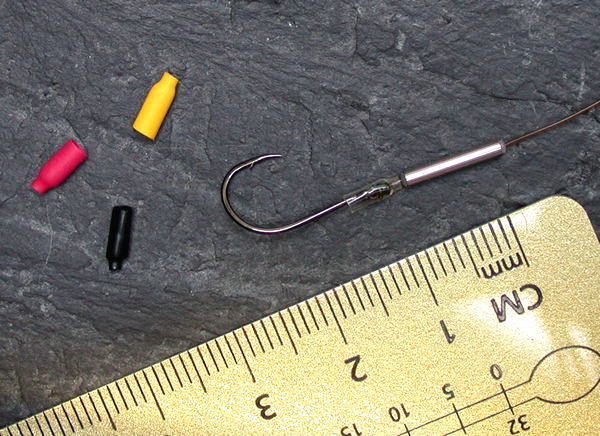
Heat Shrink Knot
Guards
Heat shrink tubing
is available in a good range of sizes and colours, allowing
knot guards to be made in a range of diameters to match the
size of the tube and hook used. The Knot Guards pictured
above are approximately 6mm long with an outside diameter of
about 2mm, creating a very small, lightweight free swinging hook link.
The clear knot guards are particularly unobtrusive.
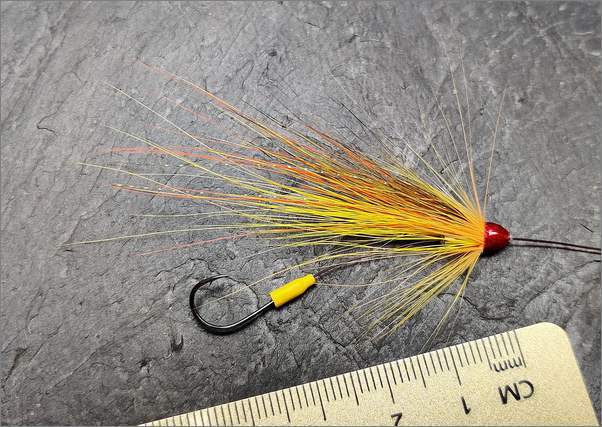
Heat Shrink Knot
Guard, Single Hook and Needle Tube Fly
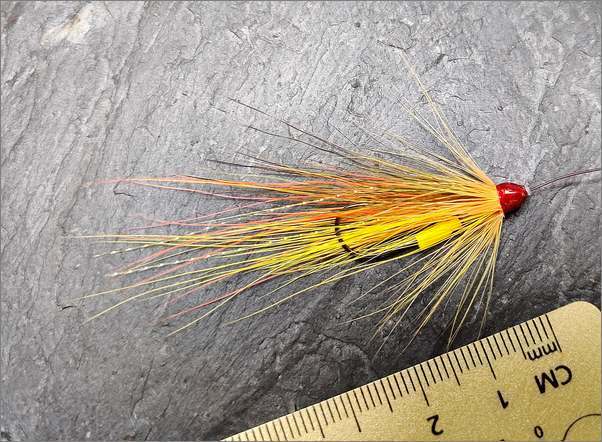
Free Swinging Tube
Fly ready to fish
A great advantage of tube flies is that
the hook used at the rear end can be selected according to
conditions and may be very easily changed or replaced, for
example when damaged, thus extending the usable life of the
tube fly. A common method of attaching the hook is to fit a
short length of flexible tubing such as PVC or silicone
rubber over the rear of the tube fly and then insert the
hook into this flexible sleeve. This is a very effective way
of keeping the hook in the desired position behind and in
line with the tube, while the flexibility of the hook link
tubing minimises leverage on the hook when a hooked fish is
being played. A single, double or treble hook may be so
employed depending on circumstance, preference and
regulation.
Many fishermen, however, prefer to
allow the tube fly hook to swing entirely freely behind the
tube fly, believing that this freedom of hook movement makes
for more efficient hooking of the fish and presents minimal
leverage when the fish is in play. The tube itself often
slides up the line out of the way when a fish is hooked.
However, if the hook is simply tied to
the line behind the tube, there is a risk that the hook will
not swim in line with the tube as intended but may instead
slide round on the knot to stick out at an angle behind the
tube. There is also a risk of increased abrasion, and
associated weakening, of the
nylon knot as the tube moves up and down the line when being
cast. To prevent this, various protective sleeves,
often referred to as swing tubes, have been
devised, commonly using short lengths of various kinds of
plastic tubing, e.g. PVC or silicone tubing, to protect the knot and help ensure that the hook swims,
as far as possible, in a straight line behind the tube fly.
Illustrated below is a simple method of
making such a knot guard/protector. The resulting
knot guard, made here simply from clear, thin-walled, light
weight heat-shrink tubing, has
the advantage of being very fine, unobtrusive and
inconspicuous, which is particularly important when using
very fine tubes such as needle tubes, for example in sea
trout night fishing or salmon fishing in low clear water.
CLICK IMAGES TO ENLARGE
How to Make the Tube Fly Knot Guard
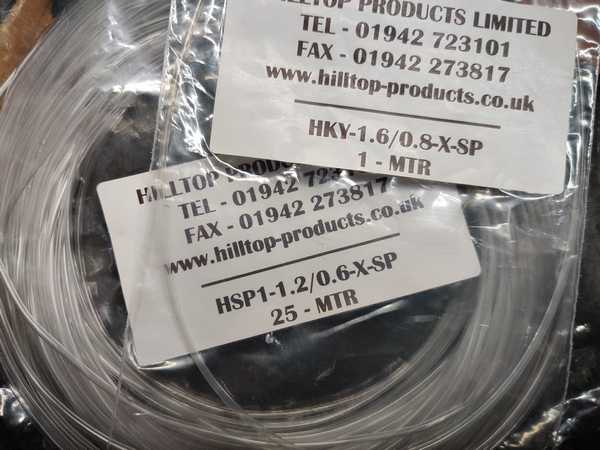
Clear heat-shrink tubing for making
a fine knot guard (or swing tube)
I have used here what I believe is the
finest heat-shrink tubing commonly available, shrinking from
an internal diameter of 1.2mm to a minimum of 0.6mm. Heat
shrink tubing is
available online, in a variety of sizes and colours, from suppliers such as
Hilltop Products . Suitable heat shrink tubing is also
available from many other online retailers, on Amazon
and on Ebay. I have found this size
(1.2/0.6mm) of heat-shrink tubing
suitable for fine single hooks up to about size 8. I use this
size with needle tubes with a diameter of 1.5mm and
1.8mm and fine, small-eyed single hooks size 10 and 8. Heat shrink tubing of a larger diameter (1.6mm,
2.0mm and
2.4mm) may be
matched to larger tubes and hooks (single, double or treble).
Note: Different
brands of heat shrink with the same specification can vary
quite a bit in size, wall thickness, flexibility etc. so it
is worth trying a few different makes to find one ideally
suited to your favourite hooks.
Guide to Heat Shrink Tubing and Hook Sizes
|
Hook Size |
Heat Shrink Internal Diameter |
|
Fine, small-eyed single hooks up to size 8 |
1.2mm shrinking to 0.6mm |
|
Larger or heavier gauge singles
up to about size 6, plus fine-eyed
tube doubles and
trebles to size 8 |
1.6mm shrinking to 0.8mm * |
|
Larger or heavier gauge singles
size 6 or above, plus
tube doubles and
trebles to size 8 |
2.0mm
shrinking to 1.0mm * |
|
Heavy wire singles, doubles and trebles
above size 6 |
2.4mm shrinking to 1.2mm |
* The 1.6/0.8mm
and 2.0/1.0mm heat shrink tubing are probably the most generally useful
sizes for British salmon fishing. Note that heat shrink
tubing in the larger diameters will also accommodate heavier
leader material and larger knots.
Step 1 - Making the
Heat-Shrink Knot Guard
Cut a short length of
heat shrink tubing (I would suggest about 5 to 7 millimetres in
length), being careful to cut the ends at right angles.
Secure a fairly heavy sewing needle in a fly tying vice and slip the heat
shrink tube on to the end of the needle, with the outer end
lying over the taper of the needle. This makes it easier to
slide the heat shrink tube off the needle when set.
Alternatively,
the heat shrink tubing may be mounted on the end of a metal
tube of suitable diameter with a millimetre or two of heat
shrink extending beyond the end of the metal tube. An
unlined stainless steel needle tube of 1.5mm diameter is
ideal for the 1.6mm heat shrink tubing or the 1.8mm needle
tube for the 2.0mm heat shrink tubing. In either case, apply the flame carefully as in this
illustration, shrinking only the first millimetre or two of
heat shrink tubing.
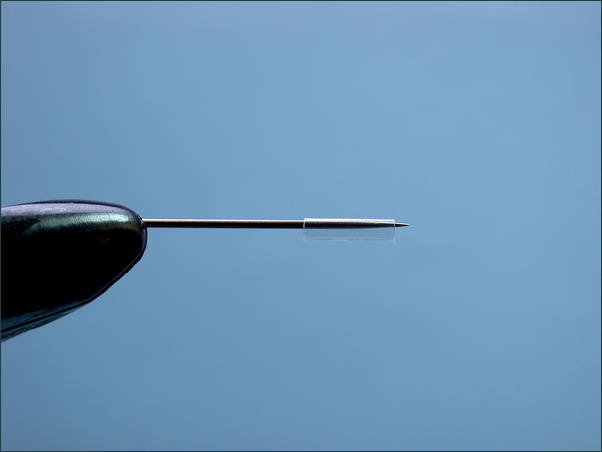
Step 2 - Making the
Heat-Shrink Knot Guard
Hold a lighter flame
near the point of the needle, gradually moving the flame
closer to the end of the heat shrink tube, being careful not
to allow the flame to touch the tube.
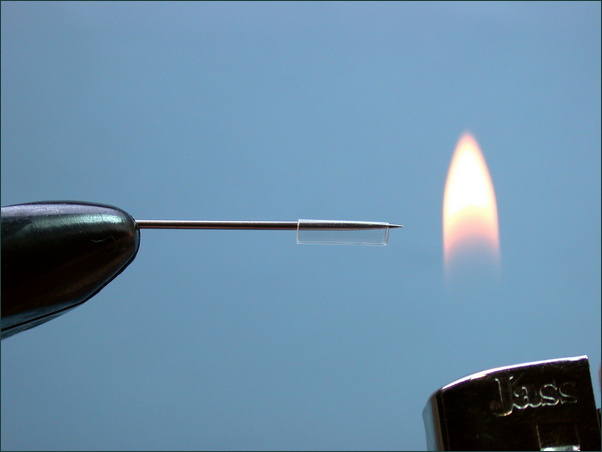
Step 3 - Making the
Heat-Shrink Knot Guard
Slowly and carefully
move the flame close to the end of the heat shrink tube
until the closest millimetre of tubing shrinks on to the taper of the needle. Allow to cool before sliding the
heat shrink knot guard off the needle. It is now ready
for use.
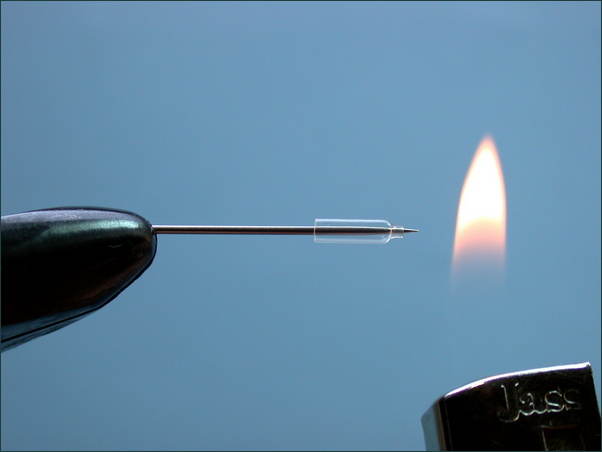
Step 4 - Using the
Heat-Shrink Knot Guard
Slip your tube fly onto
the leader, then slip on a knot guard. Now tie on your
chosen hook, be it a single, double or treble, and pull it
into the knot guard, as shown below. Allow the tube to
slide back down the leader, to rest on the end of the knot
guard. I have used here a Needle Tube Fly dressed on a
15mm long needle tube, diameter 1.5mm, 12lb Maxima
Chameleon nylon and a size 8 Gamakatsu F31 hook, with a knot
guard made using clear heat-shrink tubing size 1.2/0.6mm.
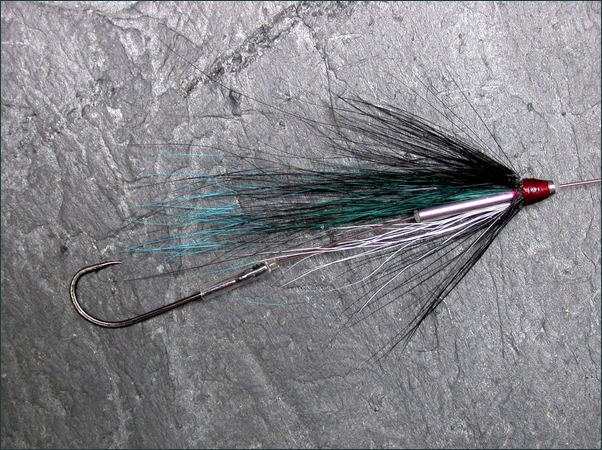
As shown below, the tube fly will be
held in place against the end of the knot guard by the
force of the river current but can move freely and
independently of the hook when a fish is hooked.
Note that the
Gamakatsu F31 has a fairly long shank, which is useful if
you want the hook point near the tail of the fly. If you
want the hook point further forward in the fly dressing, a
shorter shank hook may be used, as in the example at the top
of the page. The length of tube and dressing can, of course,
be varied as desired and used in conjunction with an
appropriately proportioned hook, be it single, double or
treble.
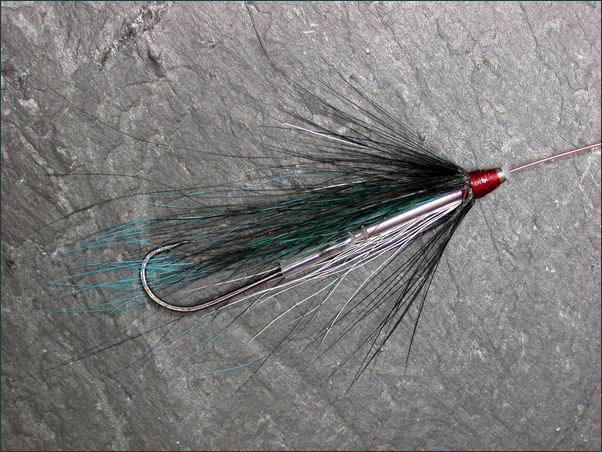
Shown below is a
selection of Needle Tube flies, primarily for sea trout, which may be used in
conjunction with the a very finest heat shrink knot guard,
matched to single hooks, or the smallest fine wire double or
treble hooks.
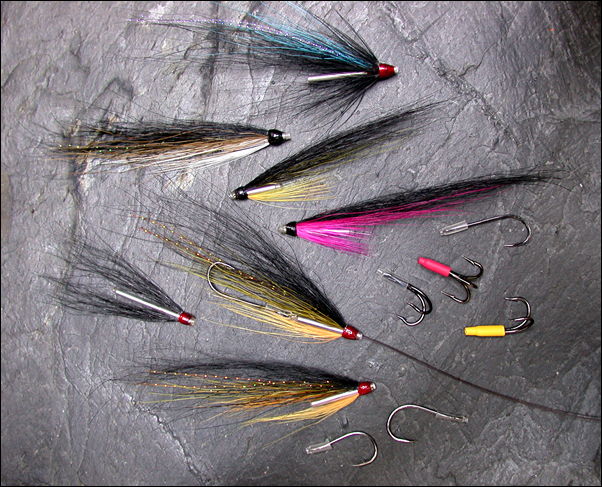
While the very finest heat shrink
tubing (1.2mm internal diameter shrinking to 0.6mm) can be
matched to the very finest wire hooks and slimmest tubes,
the most
useful sizes of heat-shrink tubing for knot guards on salmon
tube flies are probably
the 1.6/0.8mm tubing (i.e. tubing with an inside
diameter of 1.6mm, shrinking to 0.8mm when heated - the
starting (unheated) outside diameter is approximately 2mm)
and the slightly larger diameter 2.0/1.0mm tubing.
The Knot Guard may be used with single, double or treble
hooks
Examples are shown below - click to
enlarge
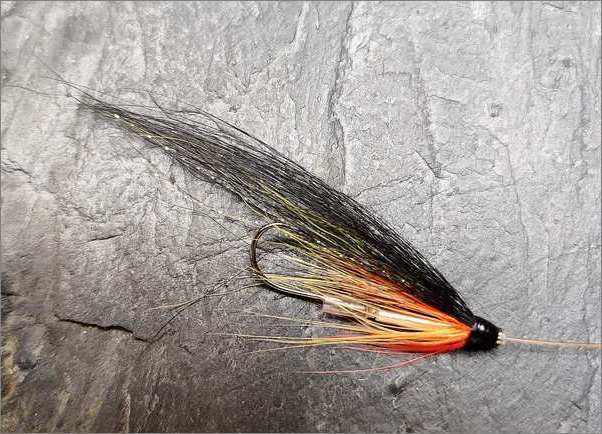
Single Hook with Knotguard
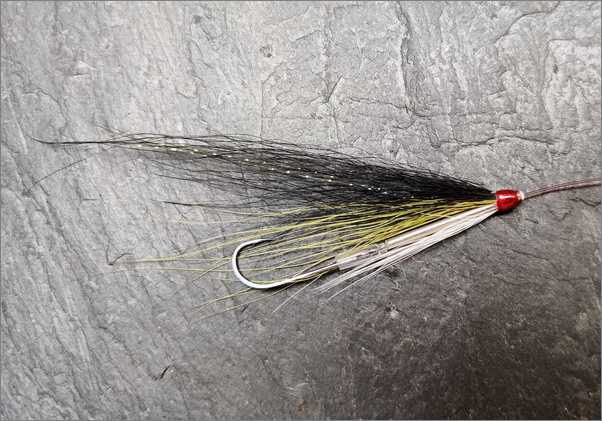
Longer Shank Single Hook with
Knotguard
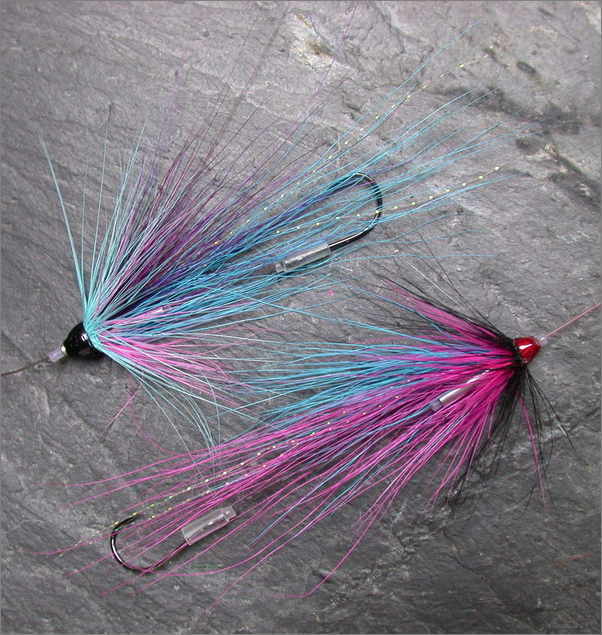
Scottish Shrimps with Single Hooks
and Knotguards
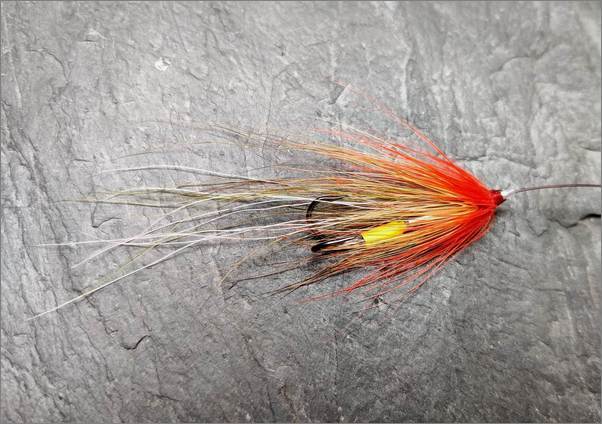
Shrimp fly with Double Hook and
Yellow Knotguard
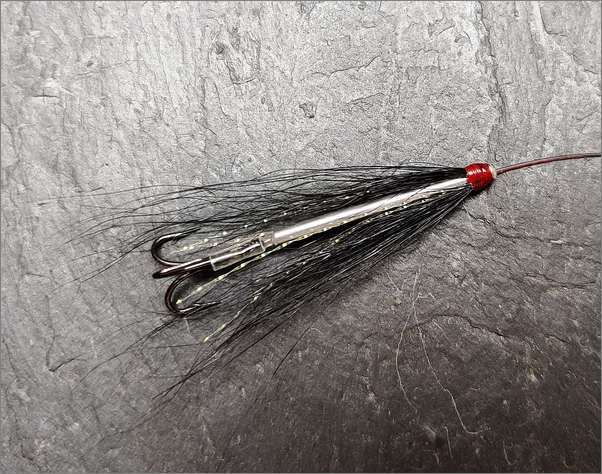
Sea Trout Needle Tube with treble
hook and Knotguard
Coloured Knot Guards for Salmon and Sea
Trout Tube Flies
Coloured heat shrink tubing in a
range of sizes offers further options for use with our
salmon and sea trout tube flies, allowing us to alter the
appearance of the fly simply by changing the colour of the
Knot Guard. Examples are shown
below. The most useful sizes of clear and coloured heat
shrink tubing for our purposes are 1.2 mm internal diameter
(shrinking to 0.6 mm), 1.6 mm (shrinking to 0.8mm) and 2.4
mm (shrinking to 1.2mm).
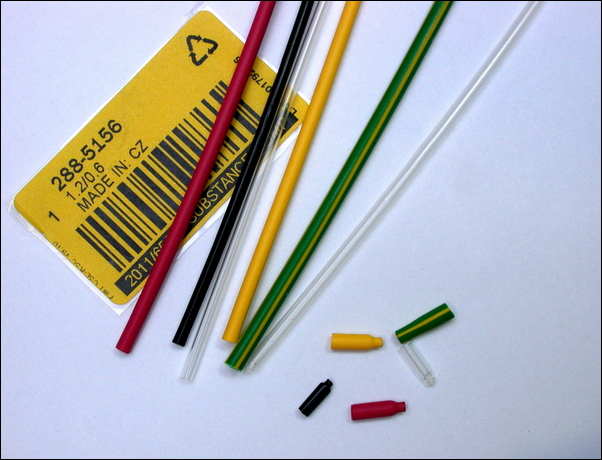
Coloured Heat
Shrink Tubing
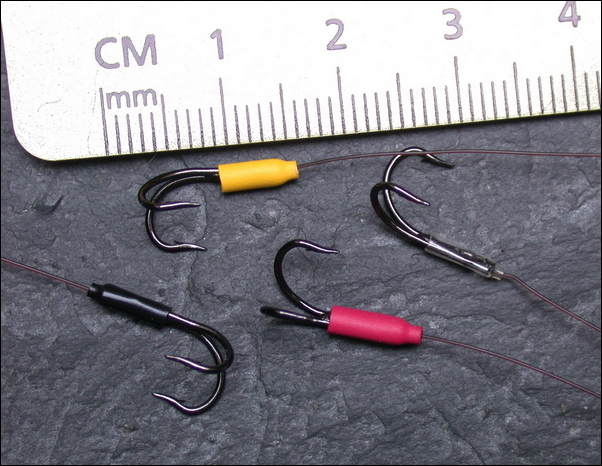
Various Coloured
Knot Guards made using 1.2mm and 1.6mm diameter heat shrink
tubing
Knot Guard with Tube Fly Double Hook
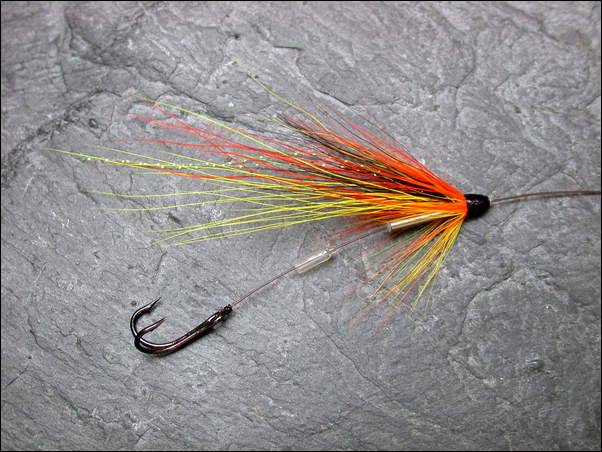
Step 1 - Slide tube
then knot guard on to leader and tie on a hook
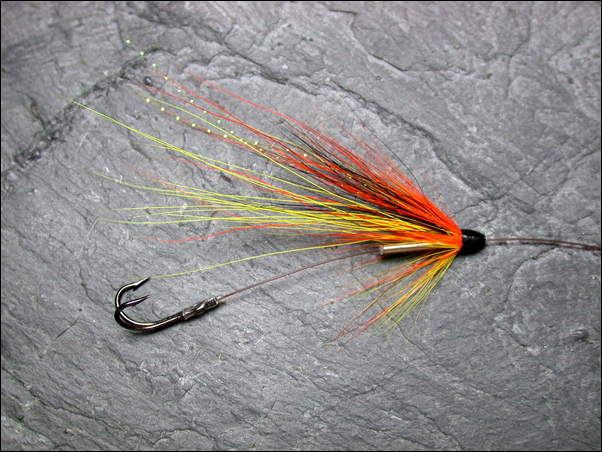
Step 2 - Slide the knot guard
down over the knot and hook eye
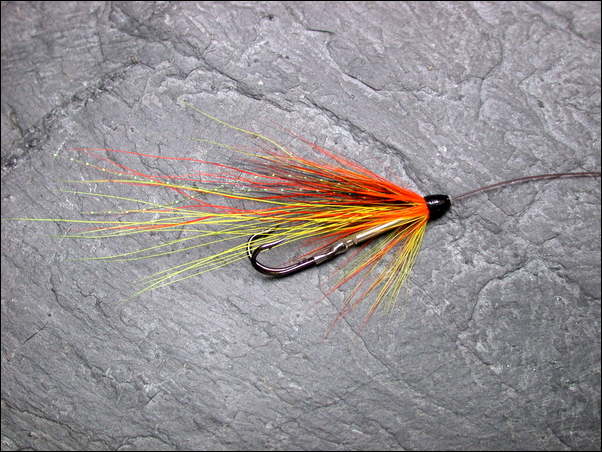
Step 3 - The knot
guard will butt up against the tube while fishing and the
tube can slide up the leader when a fish is hooked. Note
that single and double hooks will tend to swim naturally
with hook points uppermost.
Knot Guard Colour Options
Heat shrink tubing is
available in a wide range of colours
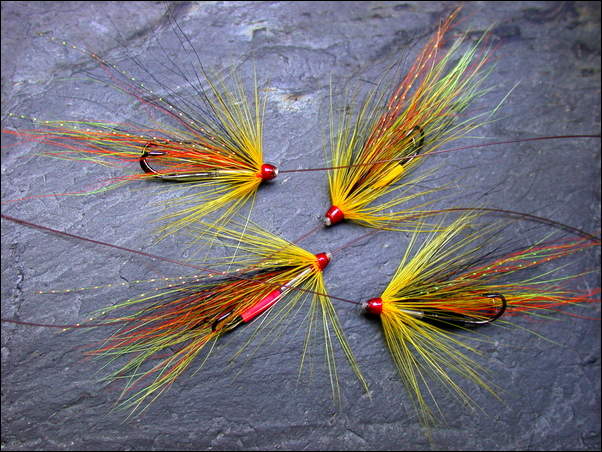
Cascade Tube Flies
with Free Swinging Double Hooks in various coloured Knot
Guards
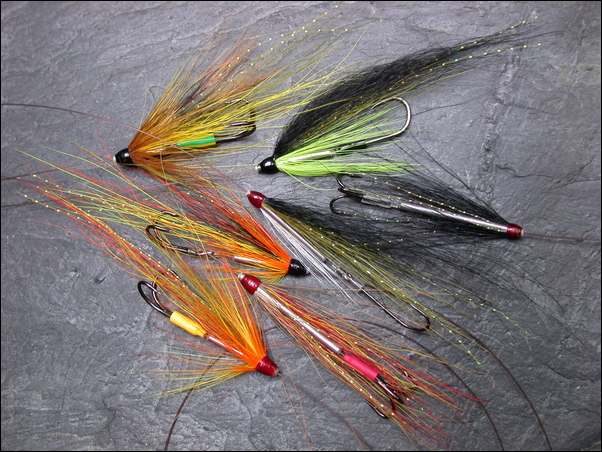
More Tube Flies
with a variety of Free Swinging hooks and Knot Guards
Hook and Knot Guard Storage
I find it convenient
to carry my hooks, with matched knot guards, together with my
tube flies in my fly box. This box has a magnetic base,
which is useful for the prevention of accidental spillage.
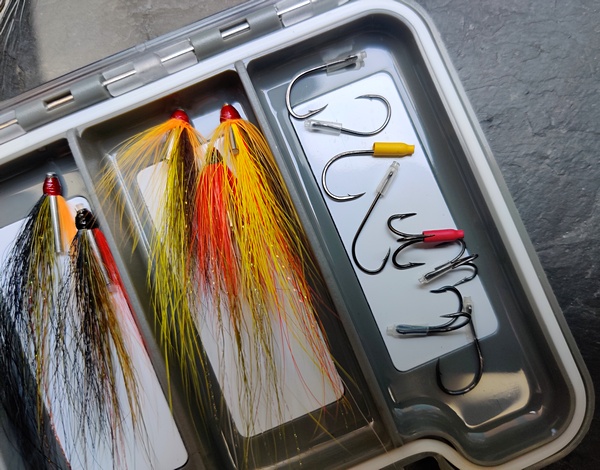
For those who like a free swinging hook
behind their tube flies, the heat-shrink knot guard
described here offers a simple, inexpensive solution. In the
lowest diameters in particular, it adds virtually no weight
or bulk to the rear end of the tube fly, allowing the fly to
swim on a more even keel. The knot guard may be made in
clear tubing or in a range of colours as illustrated above,
to either blend with or contrast the colours of the tube
fly. I have used Needle Tube
Flies fitted with a knot guard and free swinging hook, such
as those shown above, extensively during the past season. I
have found the knot guard to be effective and durable,
holding the hook securely in line with tube with no tendency
for the hook to catch on the leader or fly dressing while
casting or fishing,
and I am confident that it will prove to be
an efficient and effective method of attaching - or perhaps
more accurately, detaching - the hooks on my tube flies, a
variation on a swing tube theme already well tried and
tested.
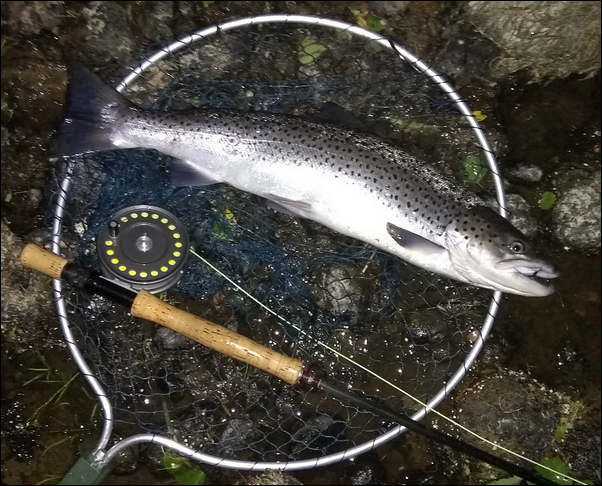
Spey sea trout taken
in June 2021 on a Needle Tube Fly with free swinging single
hook in a Knot Guard (the black and blue fly pictured above)
Sea Trout Articles |